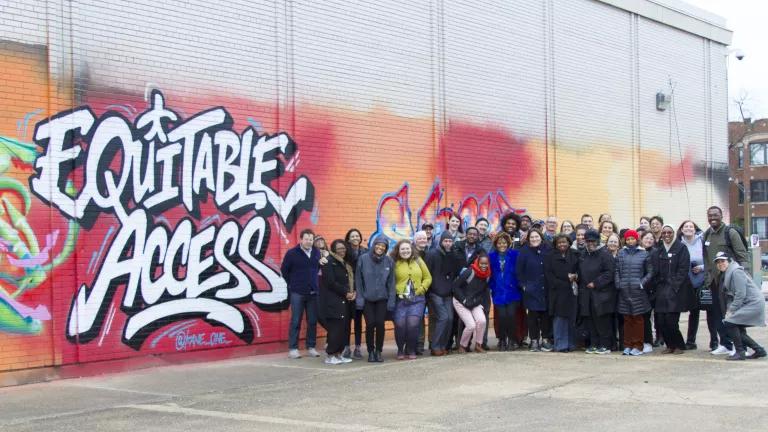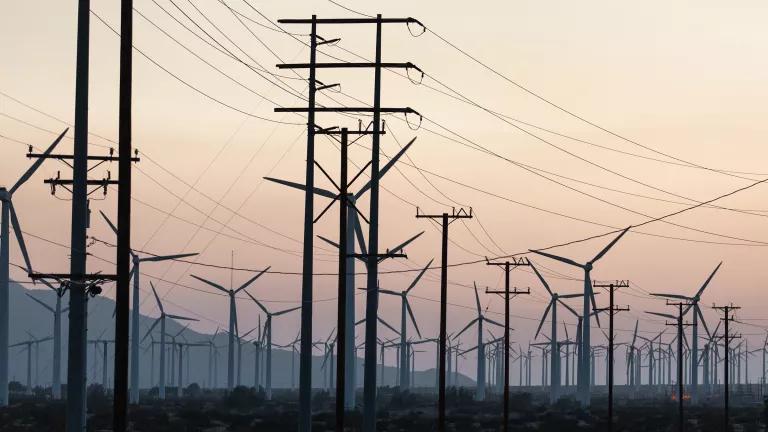ECJ Grant Model Could be Historic Opportunity for Communities
EPA's Environment & Climate Justice program may have cracked the code to inclusively direct billions of federal funds to CBOs in marginalized communities.

Getty Images
This past year, the Environmental Protection Agency (EPA) invested $3 billion in funding from the Inflation Reduction Act (IRA) in the newly-created Environmental and Climate Justice Grant Program (ECJ) to accelerate environmental justice efforts, address dangerous pollution, and support a more equitable future for US communities. Frequently noted as restrictive and rife with barriers, federal funding has been largely inaccessible to the communities who need it the most, but this program represents a historic opportunity for agencies to administer federal funding directly to marginalized environmental justice, climate justice, and frontline communities.
On his first day in office, President Biden signed the Advancing Racial Equity and Support for Underserved Communities Executive Order directing federal agencies to reform racially inequitable policies and ensure support for marginalized communities and communities of color, which relies on individual agencies likes the EPA to incorporate these policies into their programs. Yet studies show that communities of color are statistically less likely to receive equitable funding and these same communities receive fewer resources for post-disaster recovery. There are several IRA program opportunities, including the Climate Pollution Reduction Grants and the Greenhouse Gas Reduction Fund that have significant potential to address climate and environmental justice issues impacting marginalized communities.
However, unlike the programs mentioned, the ECJ program is a rare opportunity because it provides funding directly to community-based organizations. But success is not guaranteed. For this program to reach its intended recipients, marginalized communities, there needs to be a concerted effort to remove traditional barriers that stand in the way for these communities and also create flexible pathways for marginalized applicants. In partnership with Equitable and Just National Climate Forum (EJNCF), Environmental Justice Health Alliance for Chemical Policy Reform (EJHA), and Center for Neighborhood Technology (CNT), NRDC responded to the EPA’s Request for Information (RFI) focusing on how to reduce barriers and increase equitable access to grants and technical assistance. As part of this process, key environmental justice-partners and community-based partners highlighted the most common barriers they’ve faced in accessing federal grants and technical assistance and included recommendations on streamlining the application process, increasing flexibility in program design, and improving technical assistance support. If ECJ can implement these suggestions, it might have cracked the code on making federal grants accessible to CBOs.
Reduce Excessive Application & Reporting Processes
The Environmental and Climate Justice Grant program seeks to prioritize applications from the communities most adversely and disproportionately impacted by climate change, legacy pollution, and historical disinvestments. To succeed, it needs an intentional focus on bringing partners to the table and removing the current barriers to grant access and implementation. Our partners shared that there is a need to reduce excessive burdens on applicants by streamlining applications across agencies and minimizing onerous reporting methods. Bob Dean, CEO, Center for Neighborhood Technology, highlights the opportunity in the challenge, "Government agencies need to realize that their administrative requirements are getting in the way of their equity goals. If EPA is able to transform its application and reporting process for the Environmental and Climate Justice Grant program, it could serve as a model for other federal agencies as well as local and state governments to do the same.”
Firstly, to truly ensure a diverse pool of grantees, applications must require no upfront costs and have dedicated language and translation support for applicants. Applications should limit the amount of fiscal reporting that requires a higher level of staff commitment as applicants might not have development or grant staffing capacity. Requiring organizations to have either a federally approved indirect rate or use a 10% de minimis indirect rate restricts those that haven't accessed federal money before. Deliverables-based contracts (rather than contracts based on reimbursement for time spent) have much simpler invoicing requirements and should be used when possible. In addition, long, technical, legalistic contracts make it difficult for CBOs to participate because they don't have lawyers on hand to sort through.
Low-income or under-resourced applicants may not have reliable internet access, access to software, or reliable and efficient devices on which to complete applications. One potential solution is the ability for applicants to call and ask questions or complete interviews over the phone. Agencies need to ensure that there are alternative methods of submission for applicants, such as providing organizations with an application manager or grant writer support who can be reached by phone and email to respond to application questions. Smaller foundations like the San Francisco Foundation provide a breadth of grant application support and could serve as a model for wrap-around support. Transitioning to longer application deadlines and providing estimated completion time would allow community-based organizations who most need these grants to include these processes in their long-term planning.
Furthermore, communities are commonly asked to show evidence of a health, economic, environmental disparity when applying for federal assistance. Yet not all communities are able to collect this level of data, despite their lived experience of pollutants or disproportionate harm. In fact, many lack access to the data that is collected about their communities by city, state, or federal agencies. In NRDC’s comment letter, we recommended the EPA identify ways to support the collection of health and climate data and make that data accessible to community members for their own purposes. Additionally, increased flexibility in federal funding methods would greatly decrease barriers for community-based and environmental justice organizations. Many of these organizations have limited financial resources to pay in advance to complete projects and then be reimbursed for large sums. Federal grants should pay out grants in advance of the work or in installments rather than through reimbursement.
Furthermore, administrative and community engagement expenditures can often make up a larger part of the project for smaller and more community-based organizations. Authorizing a more substantial percentage of funding for community engagement allows organizations to have more inclusive stakeholder engagement, particularly with those who might be most vulnerable to project outcomes. Allowing for a higher percentage of indirect and administrative costs from budget-limited organizations would reflect the inclusivity we want to see from partners in their internal and external work. Removing as much of the financial audit process would support smaller and more-community oriented organizations who lack the finance and administrative teams of bigger organizations. Overall reduction of these common fiscal burdens allows applicants to focus on the impact of their project rather than finding resources to fill out the applications.
Reshaping Program Design for Equity
Our community-based environmental justice, climate justice organizations and technical assistance providers also identified gaps in agency program design that have excluded them from receiving funding in the past. For the ECJ program, EPA must prioritize projects in marginalized communities overburdened by pollution and climate change, projects that deliver multiple benefits, and projects that that increase collective asset ownership by members of disadvantaged communities. This includes reducing, cleaning up or preventing pollution building resilience to climate change, particularly in census tracts that:
- meet the Climate and Economic Justice Screening Tool’s (CJEST) legacy pollution or climate change thresholds.
- are identified by state-level screening tools as overburdened by pollution or climate change;
- self-identify as marginalized communities based on exposure to pollution or climate harms or past discrimination;
- or have high levels of lead in their drinking water.
An intentional focus on these communities means centering projects that uphold and further community agency and autonomy. For example, projects should be considered through a lens of long-term community impacts; for example, gentrification and displacement could push out legacy community members, people of color, and low-income families from the area. All projects must have community oversight from impacted groups and consider co-benefits including pollution reduction, emissions monitoring, improved public health and safety, good jobs and job training for community members, community owned-assets and wealth building, education and outreach, improved climate resilience and emergency preparedness, improved livability and quality of life, and other benefits.

Transforming Technical Assistance (TA) into Local Resource Hubs
As a part of their technical assistance offerings, EPA should support and actively match community, local, and regional technical assistance providers who have state and local level knowledge with applicants who require technical assistance. In addition to traditional technical assistance providers, the applicants themselves are likely well positioned to support each other as projects move through implementation. This could be an opportunity for the EPA to facilitate peer-to-peer learning, and information sharing opportunities across the applicant pool. Consideration should be given to TA organizations with diverse leadership and a clear history of successfully working with communities of color and low-income communities, recognizing that many community-based organizations do not have document retention practices or investment policies to showcase their work and mission. In addition, EPA should prioritize TA applicants who are willing to commit to agreements with community partners that establish an agreed upon understanding and commitment to self-determination, transparency, and accountability.
With the Inflation Reduction Act, the Bipartisan Infrastructure Law and other historic federal funding pools moving billions into critical programs across federal agencies, this new program constitutes an unprecedented opportunity to support environmental justice communities, climate justice communities, low-income communities, and communities of color across the US. Deya Zavala, Managing Director, National Equitable Recovery Alliance, BARHII, stated, "We're inspired by the growing momentum of equity innovators across the country as we reshape federal programs for equity & what these changes could mean when it comes to bringing once in a lifetime investment into communities." The ECJ program has the ability to shift millions directly into the communities that are most impacted, and more broadly, could model how federal grants can be utilized as a lever to shift power and resources back to marginalized and disadvantaged communities who are facing the brunt of climate, pollution, and health impacts.
You can read more about how to prepare to apply for the EPA Environmental & Climate Justice Grant Program Notice of Funding (to be released Autumn 2023) and about other Inflation Reduction Act funding opportunities that address environmental and climate injustice in communities.





